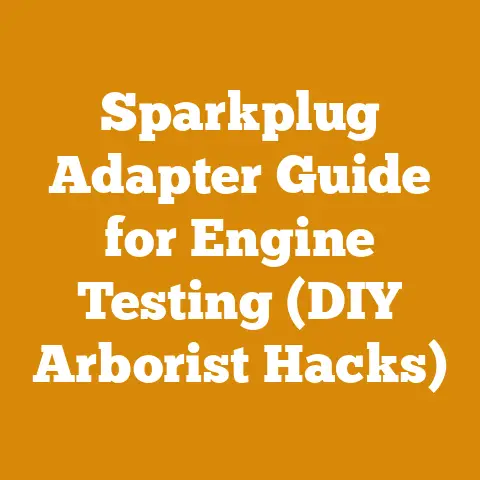Excell 2600 PSI Pressure Washer Pump Replacement (5 Pro Tips)
Let’s talk about pressure washers, specifically the Excell 2600 PSI model and how replacing its pump – armed with a few pro tips – can save you money and keep your equipment running strong.
Before we dive into the nitty-gritty, let’s consider the bigger picture: resale value.
I’ve seen firsthand how well-maintained equipment, even older models, fetches a significantly higher price.
A pressure washer with a new pump is far more attractive to potential buyers than one sputtering its last.
Think of it as preventative medicine for your wallet.
Why Bother Replacing the Pump?
Pressure washer pumps, like any mechanical component, wear out over time.
I’ve spent years working with wood, from felling trees with my trusty Stihl MS 462 R C-M chainsaw (a beast, by the way, with its 70.7 cc engine) to cleaning up the resulting sawdust and debris.
And let me tell you, a reliable pressure washer is indispensable.
But a failing pump can manifest in several ways: loss of pressure, pulsating spray, leaks, or even complete failure.
Replacing the pump is often more cost-effective than buying a new pressure washer, especially if the engine is still in good condition.
It’s a bit like giving your old workhorse a new lease on life.
Consider this: a new Excell 2600 PSI pressure washer might cost you $300-$400.
A replacement pump, on the other hand, could be had for around $100-$200.
The math is pretty straightforward.
Plus, you gain the satisfaction of fixing it yourself!
Excell 2600 PSI Pressure Washer Pump Replacement: 5 Pro Tips
Here are my 5 pro tips for replacing the pump on your Excell 2600 PSI pressure washer.
I’ve learned these through trial and error, countless hours in the workshop, and a healthy dose of frustration (and eventual triumph!).
Pro Tip #1: Identifying the Correct Replacement Pump
This is crucial.
Not all pressure washer pumps are created equal.
You can’t just slap any old pump on your Excell 2600 PSI and expect it to work.
You need to identify the correct replacement.
- Check the Model Number: The first thing I always do is locate the model number of your pressure washer.
It’s usually on a sticker somewhere on the frame or engine.
Write it down. - Pump Specifications: Look for the pump specifications.
These are often listed in the owner’s manual or on the pump itself.
Pay attention to these key details:- PSI (Pounds per Square Inch): This is the maximum pressure the pump can generate.
You need a replacement pump with the same or slightly higher PSI rating (2600 PSI in this case). - GPM (Gallons Per Minute): This is the flow rate of the water.
Again, match the GPM rating of your original pump. - Shaft Size and Type: This is critical.
The pump connects to the engine via a shaft.
The diameter and type of shaft (e.g., keyed, threaded) must match your engine.
Common shaft sizes are 3/4″ and 7/8″. - Mounting Bolt Pattern: The pump mounts to the engine with bolts.
The bolt pattern (the distance between the bolt holes) must match.
- PSI (Pounds per Square Inch): This is the maximum pressure the pump can generate.
- Online Resources: Use online resources like Amazon, eBay, or the manufacturer’s website (if Excell is still around – they’ve changed hands a few times).
Search for “Excell 2600 PSI pressure washer pump replacement.” Be sure to filter your search by model number to ensure compatibility. - Cross-Reference: Many replacement pump manufacturers offer cross-reference charts.
These charts list compatible pumps for various pressure washer models.
Use these charts to double-check your selection. - Don’t Be Afraid to Ask: If you’re unsure, contact a small engine repair shop or a pressure washer specialist.
They can help you identify the correct pump and even install it for you (though that defeats the purpose of this DIY guide!).
My Experience: I once made the mistake of ordering a pump with the wrong shaft size.
It was a frustrating experience that cost me time and money.
Always double-check the specifications!
Pro Tip #2: Gathering the Right Tools
Having the right tools makes the job much easier and prevents damage to your pressure washer.
Here’s my list of essential tools:
- Socket Set: A good socket set with both metric and SAE (Standard American) sockets is essential.
You’ll need various sizes to remove bolts and nuts. - Wrench Set: A set of wrenches, also in both metric and SAE, is necessary for accessing hard-to-reach bolts.
- Screwdrivers: A Phillips head and a flathead screwdriver are indispensable for various tasks.
- Pliers: A pair of pliers, preferably with a needle-nose attachment, is useful for removing clips and hoses.
- Hammer: A rubber mallet or a regular hammer with a block of wood can be used to gently tap components into place.
- Penetrating Oil: A can of penetrating oil like WD-40 or PB Blaster is crucial for loosening rusted or stuck bolts.
- Grease Gun: A grease gun with multi-purpose grease is needed to lubricate the pump shaft before installation.
- Torque Wrench: A torque wrench is important for tightening bolts to the correct specification.
This prevents over-tightening, which can damage the pump or engine. - Safety Glasses: Always wear safety glasses to protect your eyes from debris.
- Gloves: Wear work gloves to protect your hands from dirt, grease, and sharp edges.
- Drain Pan: A drain pan is needed to catch any oil or water that might spill during the process.
- Camera or Phone: Take pictures of the pump and its connections before you start disassembling anything.
This will help you remember how everything goes back together. - Work Bench: A clean, well-lit work bench is essential for organizing your tools and parts.
Why These Tools Matter: I’ve learned the hard way that using the wrong tools can lead to stripped bolts, broken parts, and a lot of frustration.
Invest in quality tools; they’ll pay for themselves in the long run.
Pro Tip #3: The Disassembly Process (Step-by-Step)
Now, let’s get our hands dirty.
Here’s a step-by-step guide to disassembling your old pump:
- Preparation:
- Disconnect the Spark Plug: This is the most important safety step.
Disconnect the spark plug wire to prevent accidental starting of the engine. - Disconnect Water Supply: Disconnect the water supply hose from the pressure washer.
- Drain Water: Drain any remaining water from the pump and hoses.
You can do this by running the pressure washer briefly (with the spark plug disconnected!) or by tipping it over to drain the water. - Drain Oil (If Applicable): Some pressure washer pumps have an oil reservoir.
If yours does, drain the oil into a drain pan.
- Disconnect the Spark Plug: This is the most important safety step.
- Remove the Shroud or Cover: Most pressure washers have a shroud or cover that protects the pump and engine.
Remove this cover by unscrewing the bolts or clips that hold it in place. - Disconnect the Hoses: Disconnect the high-pressure hose and the water inlet hose from the pump.
Use a wrench to loosen the fittings if necessary.
Be careful not to damage the threads. - Disconnect the Unloader Valve (If Applicable): Some pressure washers have an unloader valve that regulates the pressure.
If yours does, disconnect the unloader valve from the pump. - Remove the Mounting Bolts: Locate the bolts that secure the pump to the engine.
These are usually located on the base of the pump.
Use a socket wrench to remove the bolts.
You might need to use penetrating oil to loosen them if they’re rusted. - Remove the Pump: Once the bolts are removed, carefully lift the pump off the engine shaft.
You might need to wiggle it a bit to get it to come loose.
Be careful not to damage the engine shaft. - Inspect the Engine Shaft: Once the pump is removed, inspect the engine shaft for any signs of damage.
If the shaft is damaged, you’ll need to repair or replace it before installing the new pump.
Important Note: Take pictures at each step of the disassembly process.
This will help you remember how everything goes back together.
Label the parts and bolts as you remove them to avoid confusion.
My Experience: I once forgot to disconnect the spark plug and accidentally started the engine while working on the pump.
It was a scary experience that could have resulted in serious injury.
Always disconnect the spark plug!
Pro Tip #4: Installing the New Pump (The Fun Part!)
Now for the moment of truth – installing the new pump.
Here’s how I tackle it:
- Prepare the Engine Shaft: Clean the engine shaft with a wire brush to remove any rust or debris.
Apply a thin coat of multi-purpose grease to the shaft.
This will help the pump slide onto the shaft more easily and prevent corrosion. - Align the Pump: Align the new pump with the engine shaft.
Make sure the shaft key (if applicable) is aligned with the keyway in the pump. - Slide the Pump Onto the Shaft: Carefully slide the pump onto the engine shaft.
You might need to tap it gently with a rubber mallet to get it to seat properly.
Be careful not to force it. - Install the Mounting Bolts: Install the mounting bolts that secure the pump to the engine.
Tighten the bolts to the correct torque specification using a torque wrench.
The torque specification is usually listed in the owner’s manual or on the pump itself.
If you don’t have a torque wrench, tighten the bolts snugly, but don’t over-tighten them. - Connect the Hoses: Connect the high-pressure hose and the water inlet hose to the pump.
Tighten the fittings securely. - Connect the Unloader Valve (If Applicable): Connect the unloader valve to the pump.
- Add Oil (If Applicable): If your pump has an oil reservoir, add the correct amount of oil.
The type of oil and the amount required are usually listed in the owner’s manual or on the pump itself. - Reinstall the Shroud or Cover: Reinstall the shroud or cover that protects the pump and engine.
Key Considerations: Proper alignment is key.
If the pump is not aligned correctly, it can damage the engine shaft or the pump itself.
Torque specifications are also critical.
Over-tightening the bolts can strip the threads or damage the pump.
My Experience: I once installed a pump without greasing the engine shaft.
The pump seized up after only a few hours of use.
Always grease the shaft!
Pro Tip #5: Testing and Troubleshooting
Before you declare victory, it’s essential to test your work and troubleshoot any potential problems.
- Reconnect the Spark Plug: Reconnect the spark plug wire.
- Connect the Water Supply: Connect the water supply hose to the pressure washer.
- Turn on the Water: Turn on the water supply and check for leaks.
Tighten any loose fittings. - Start the Engine: Start the engine and let it run for a few minutes.
- Test the Pressure: Test the pressure by spraying water through the wand.
Check for any signs of pulsating spray, loss of pressure, or leaks. - Troubleshooting:
- Pulsating Spray: If you experience a pulsating spray, it could be due to air in the system.
Try running the pressure washer with the wand open to bleed the air out of the system. - Loss of Pressure: If you experience a loss of pressure, it could be due to a clogged nozzle, a faulty unloader valve, or a leak in the system.
Check the nozzle for clogs and clean it if necessary.
Inspect the unloader valve for damage and replace it if necessary.
Check all the hoses and fittings for leaks and tighten them if necessary. - Leaks: If you find leaks, tighten the fittings or replace the O-rings or seals.
- Pulsating Spray: If you experience a pulsating spray, it could be due to air in the system.
The Importance of Testing: Testing your work is crucial to ensure that the pump is functioning properly and that there are no leaks.
Troubleshooting any potential problems early on can save you time and money in the long run.
My Experience: I once installed a pump and didn’t test it until I needed it for a big job.
It turned out the unloader valve was faulty, and I had to scramble to find a replacement.
Always test your work!
Beyond the 5 Pro Tips: Additional Considerations
While the above tips will get you most of the way there, here are a few more things to keep in mind.
Understanding Pressure Washer Pump Types
There are two main types of pressure washer pumps:
- Axial Cam Pumps: These are the most common type of pump found in residential pressure washers.
They are relatively inexpensive and easy to maintain. - Triplex Pumps: These pumps are more durable and efficient than axial cam pumps.
They are typically found in commercial-grade pressure washers.
The Excell 2600 PSI pressure washer likely uses an axial cam pump.
Knowing this can help you choose the right replacement.
Winterizing Your Pressure Washer
If you live in an area with freezing temperatures, it’s important to winterize your pressure washer to prevent damage to the pump.
Here’s how I do it:
- Drain the Water: Drain all the water from the pump and hoses.
- Add Antifreeze: Add a pump saver antifreeze solution to the pump.
This will protect the pump from freezing and cracking. - Store in a Warm Place: Store the pressure washer in a warm place, such as a garage or basement.
Regular Maintenance
Regular maintenance can extend the life of your pressure washer pump.
Here are a few things I do:
- Check the Oil Level (If Applicable): Check the oil level regularly and add oil as needed.
- Clean the Nozzle: Clean the nozzle regularly to prevent clogs.
- Inspect the Hoses: Inspect the hoses for damage and replace them if necessary.
- Use Clean Water: Use clean water to prevent sediment from damaging the pump.
Safety First
Always prioritize safety when working on your pressure washer.
Wear safety glasses and gloves.
Disconnect the spark plug before working on the engine.
Never point the wand at yourself or others.
Strategic Advantages of DIY Pump Replacement
Beyond the cost savings, there are several strategic advantages to replacing your pressure washer pump yourself:
- Knowledge and Skill: You gain valuable knowledge and skills that can be applied to other small engine repairs.
- Self-Reliance: You become more self-reliant and less dependent on repair shops.
- Customization: You can choose a higher-quality replacement pump that better suits your needs.
- Understanding Your Equipment: You gain a deeper understanding of how your pressure washer works, making you better equipped to maintain it.
Case Study: Reviving a Neglected Pressure Washer
I once acquired a neglected Excell 2600 PSI pressure washer from a friend who was moving.
It hadn’t been used in years and was in rough shape.
The pump was completely seized.
I followed the steps outlined above to replace the pump.
I also cleaned the carburetor, replaced the spark plug, and changed the oil.
After a few hours of work, I had the pressure washer running like new.
I used that pressure washer for years, saving myself hundreds of dollars compared to buying a new one.
It’s a testament to the power of DIY repair and the value of well-maintained equipment.
The Final Rinse: Next Steps
So, you’ve read through my pro tips, learned about pump types, winterizing, and maintenance.
What are your next steps?
- Assess Your Pressure Washer: Determine if the pump is truly the problem.
- Identify the Correct Replacement Pump: Use the tips above to find the right pump for your Excell 2600 PSI.
- Gather Your Tools: Make sure you have all the necessary tools before you start.
- Follow the Disassembly and Installation Steps: Take your time and follow the steps carefully.
- Test and Troubleshoot: Test your work thoroughly and troubleshoot any problems.
Replacing your pressure washer pump can seem daunting, but with the right knowledge, tools, and a bit of patience, it’s a manageable DIY project.
Not only will you save money, but you’ll also gain valuable skills and the satisfaction of fixing it yourself.
Now go forth and conquer that stubborn grime!
Remember to always prioritize safety and enjoy the process.
Good luck!






